This strawberry jam is by far, the easiest jam recipe to make with a low amount of sugar and without packaged pectin.
It has a soft, velvety texture, that's bursting with fresh strawberry flavor and it spreads like a dream!
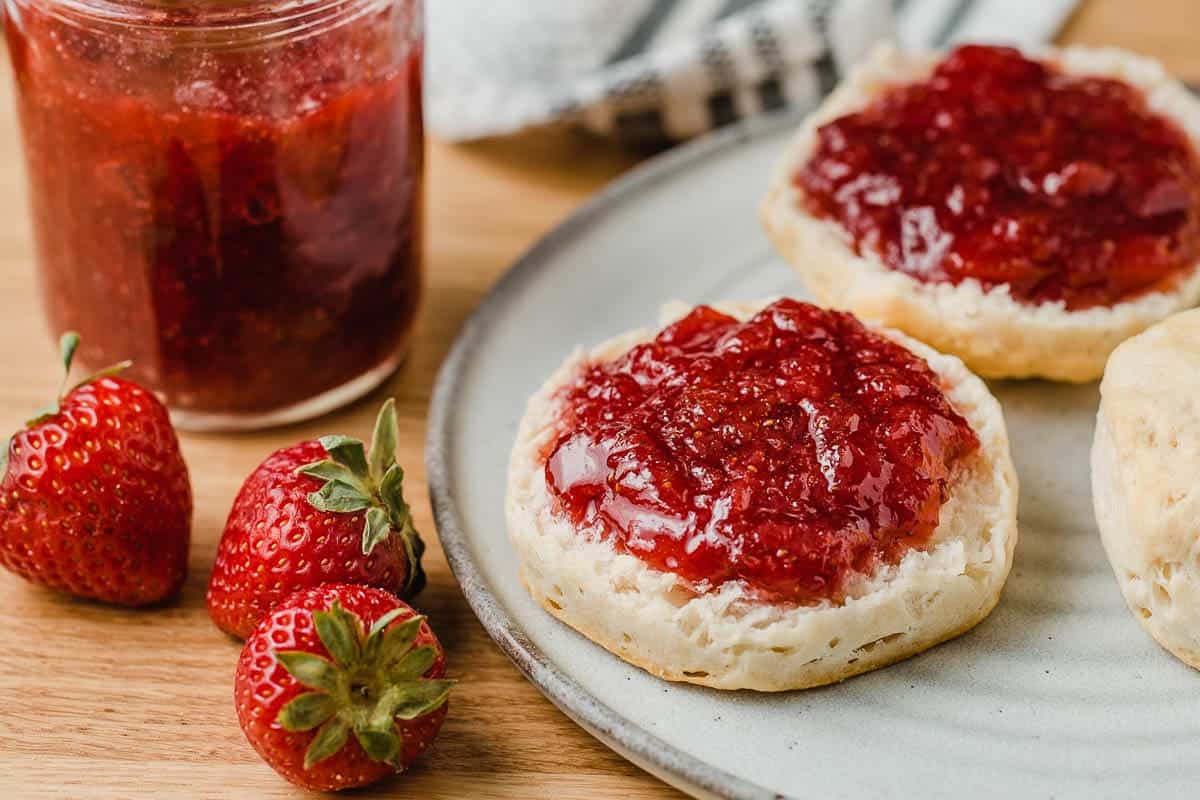
Homemade strawberry jam is the perfect recipe to make when strawberries are in season!
There's nothing better than homemade jam spread over sourdough biscuits or toasted sourdough english muffins!
Juicy, ripened strawberries are mixed with sugar and left to sit for an hour or more allowing the berries to release their natural juices.
This extra step, referred to as macerating the fruit, helps to soften the berries, dissolve the sugar and cut down on cooking time.
Less cooking time means more fresh strawberry flavor!
Because this is a low sugar jam recipe, there's just the right amount of sweetness to let the strawberry flavor shine in every bite.
The jam is naturally thickened with the pectin from an apple and can be stored in the fridge for up to 2 months.
Because the recipe includes the use of bottled lemon juice, it can be preserved safely through water bath canning.
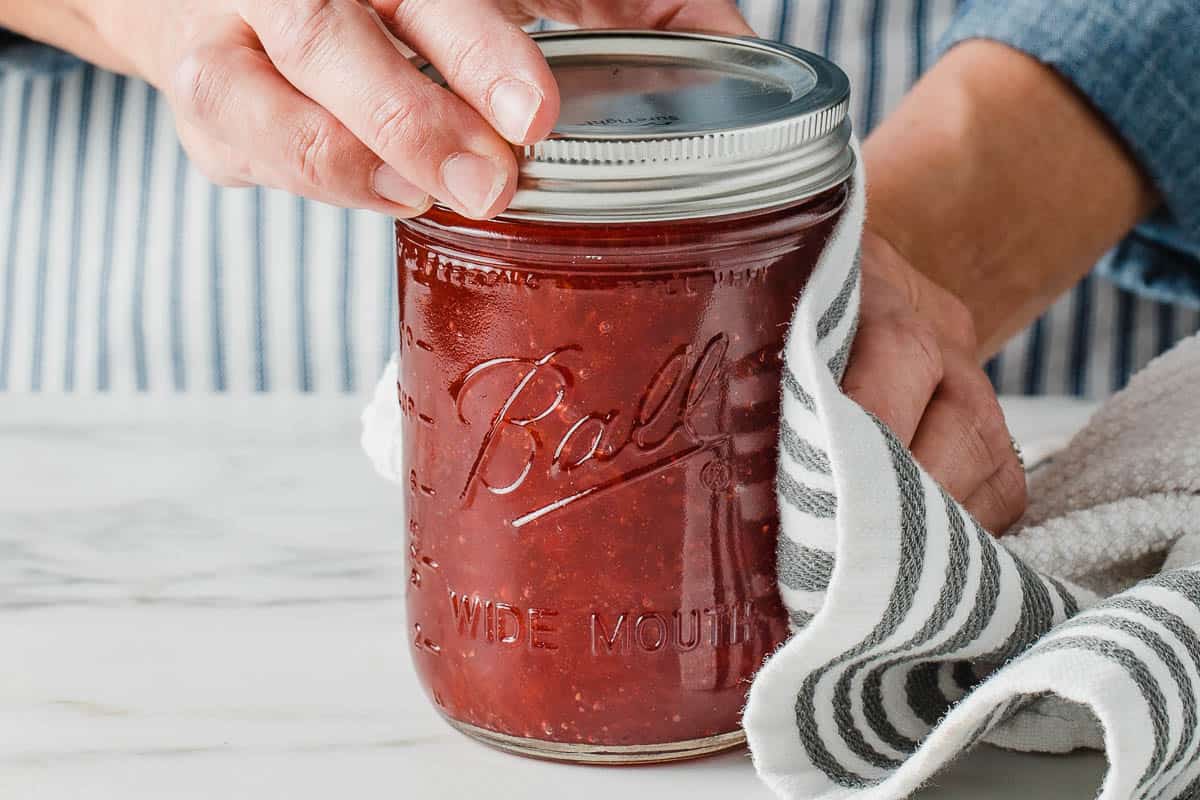
Equipment needed
- large mixing bowl (affiliate link)
- measuring cups and spoons (affiliate link)
- grater (affiliate link)
- large stockpot (5.5 quarts or larger) (affiliate link)
- large heat-safe spoon (affiliate link) for stirring hot jam
- half pint glass jars (affiliate link) with lids and rings
- quart glass jars (affiliate link) with lids and rings
- small glass plate (to test jam for doneness)
- jar funnel (affiliate link)
- ladle (affiliate link)
- digital thermometer (affiliate link)
- (optional) water-bath canner and canning equipment
Prepare ingredients and jars
This recipe makes about (5) half pint jars.
- Wash 3 lbs. fresh strawberries, remove the stems and cut the berries into small pieces. Crush the fruit with your hands or a potato masher and measure out 6 cups of crushed strawberries into a large bowl.
- Stir in 3 cups of granulated sugar and let the mixture sit for one hour on the counter.
- Place a small glass plate in the freezer. (You'll use it to test the jam for doneness later.)
- While the mixture is macerating, prepare your jars.
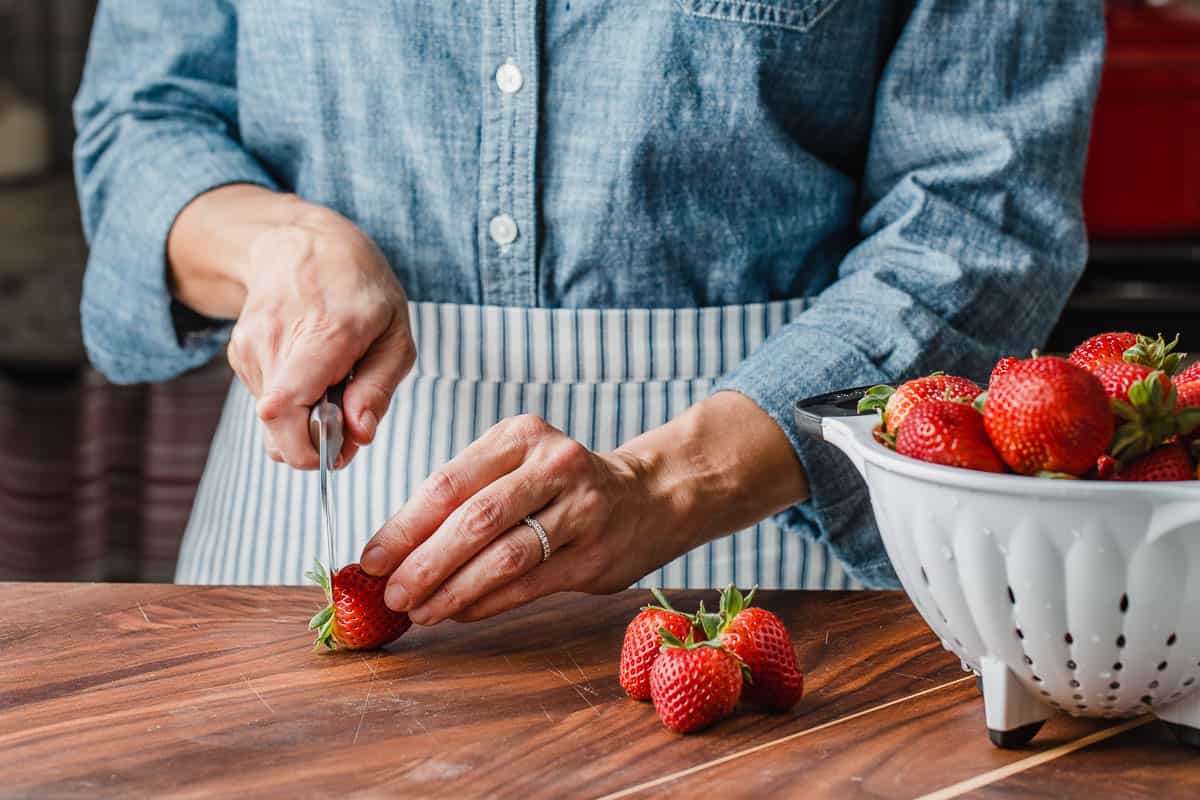
Hot jam needs to go into hot jars to prevent temperature shock to the glass.
Jars processed in a water-bath canner for 10 or more minutes, do not need to be pre-sterilized according to the National Center for Home Food Preservation. However, they still need to be hot when you fill them with the jam.
Wash the jars, lids and rings with hot, soapy water, making sure to rinse well.
Place the clean jars in your water-bath canner and cover with water. Let the water simmer while cooking the jam to keep the jars hot.
To sterilize your jars without a canner, preheat your oven to 175°F (79°C). Arrange the washed and rinsed jars on a baking sheet and place in the preheated oven for 25 minutes. Turn off the oven, leaving the jars inside to stay hot while you make the jam.
You can also clean, sterilize and keep the jars hot on the sanitize setting in your dishwasher.
- After the strawberries and sugar have macerated for one hour, peel, core and grate 1 medium apple. Granny Smith apples are a good choice because they contain high levels of pectin.
- Add 2 tablespoons of bottled lemon juice to the mixture. It is important to use bottled lemon juice to ensure the acidity or ph level of the jam is safe for canning. (If you are not canning the jam, fresh lemon juice can be substituted.)
How to cook the jam
After the lemon juice and grated apple are added, transfer the mixture to a large stockpot that is 5.5 quarts or larger.
Bring to a boil over medium-high heat.
Let the mixture come to a boil that can't be stopped while stirring. This is very important. When I test the temperature of my jam with a digital thermometer, it registers between 212-216°F (100-102°C) at a rolling boil.
Once it reaches a rolling boil that can't be stirred down, set a timer for 20 minutes. Stir constantly to prevent the jam from boiling over.
As the mixture thickens toward the end of the cooking process, the foam will start to subside.
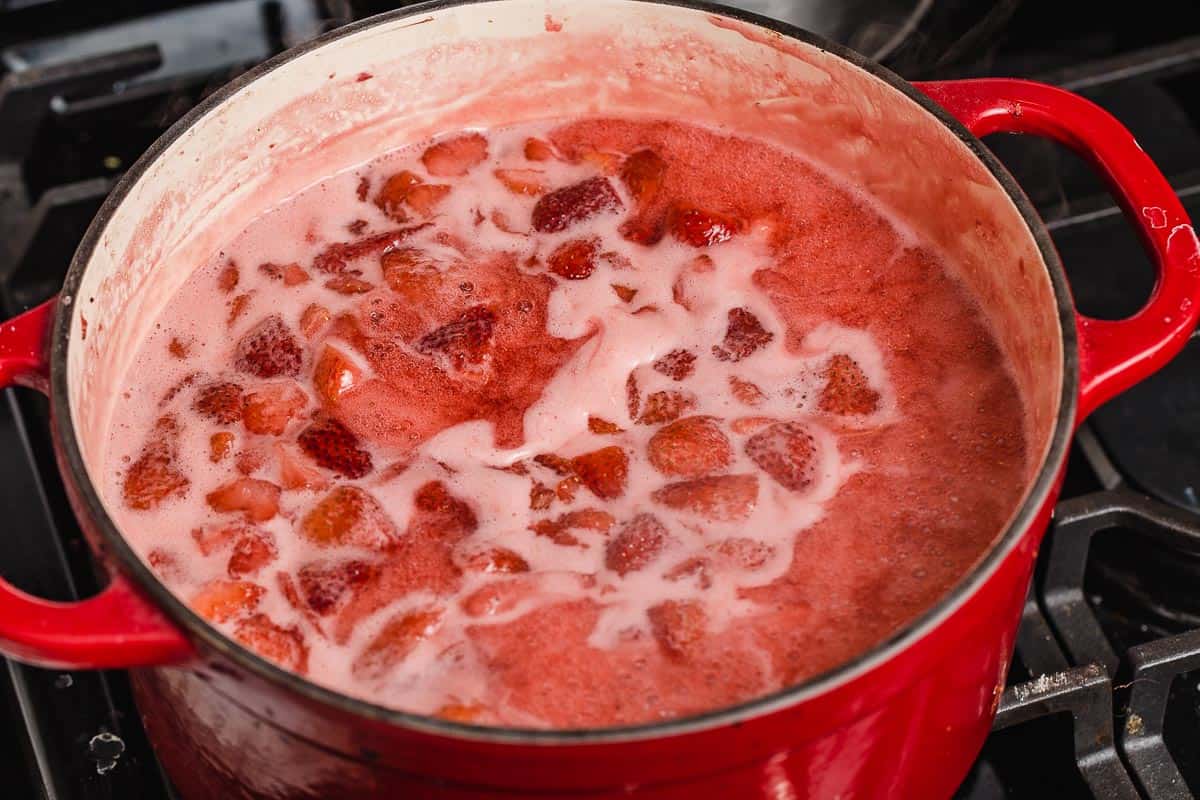
Once the timer goes off, turn off the heat and test for doneness.
How to test jam for doneness
When you're ready to test your jam, remove the glass plate from your freezer.
Drop a spoonful of the hot jam onto the cold plate. Return the plate to the freezer for 2 minutes.
Remove the plate and run your finger through the jam. If the jam stays separated, it's ready!
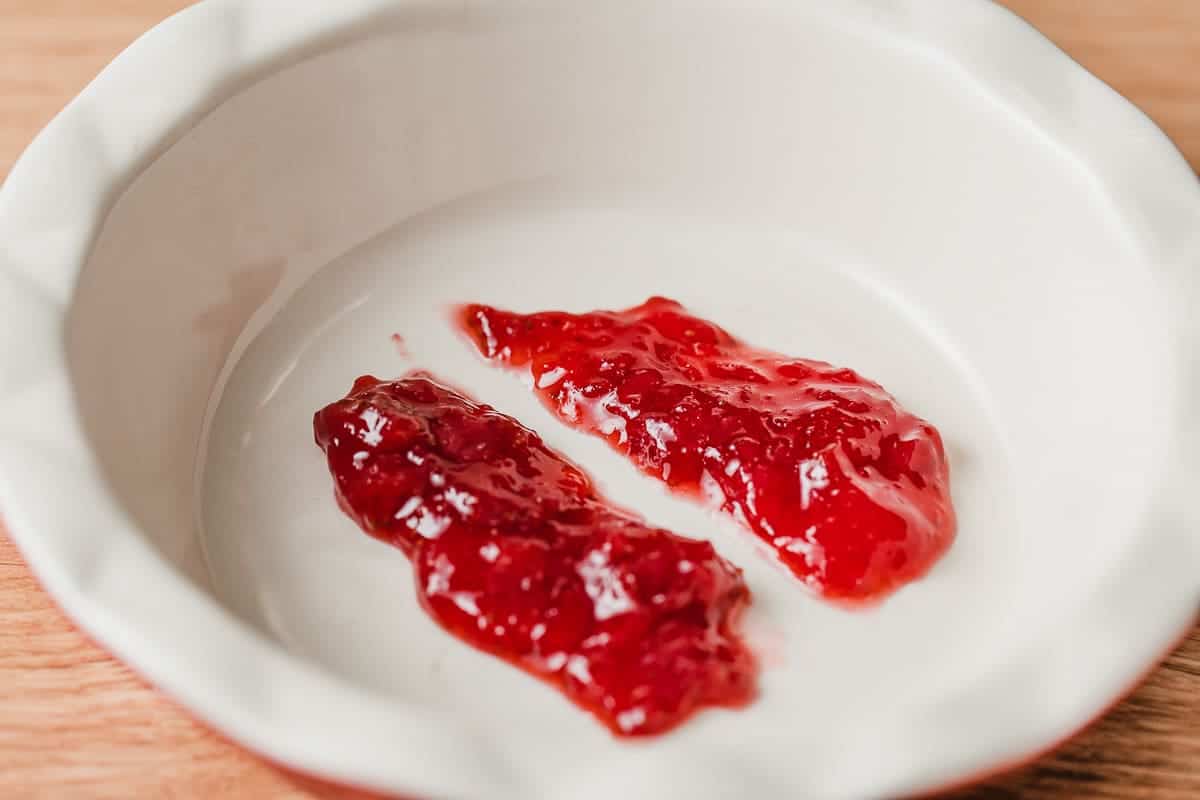
If the jam oozes back together, cook 5 more minutes and retest.
Before filling the jars, skim any foam from the top of the jam using a large spoon.
Use a jar funnel and a ladle to fill the hot jars, leaving a ¼" headspace. Screw on the lids and rings.
If you plan to store your jam in the fridge, feel free to use larger jars such as pint size or quart size.
How to store without canning
Let jam cool completely after filling the jars, and then refrigerate them until set, about 2 hours, before eating.
This strawberry jam can be refrigerated for up to 2 months unopened. Once you've opened the jar, make sure to eat the jam within 1 month and keep it stored in the fridge.
Canning Instructions
Properly preserved jam can be stored on your pantry shelf, for 18 months or longer unopened. It's very easy and doesn't take much time at all!
Ladle the hot strawberry jam into half-pint jars, leaving a ¼" headspace. De-bubble the jar and wipe the rim with a towel dipped in hot water or vinegar to remove any residue on the rim. (steps 1-4)
Food left on the rim can prevent a proper seal.
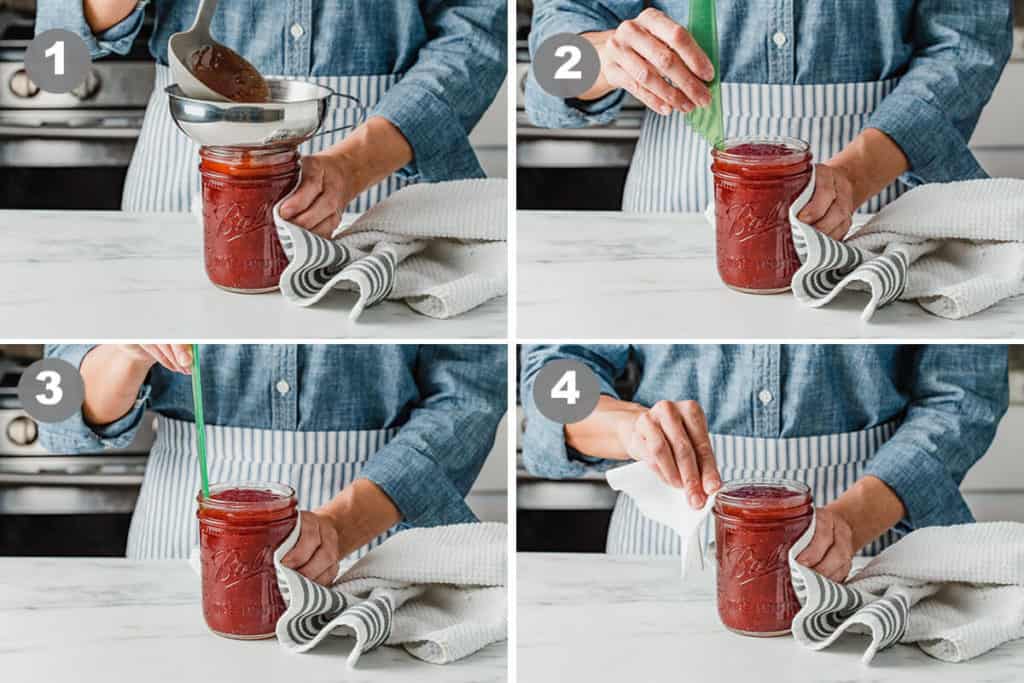
Center a canning lid on the jar and screw bands down evenly and firmly just until a point of resistance is met. This is referred to as "fingertip-tight". (step 5)
Over-tightening bands can prevent air from escaping out of the jars, resulting in buckled lids or seal failure.
Use the jar lifter to place it back into the canner and repeat with the remaining jars. (step 6)

If there is not enough jam to fill the 5th half pint jar within a ¼" of headspace, simply store it in the fridge. Do not process it in the canner as it will not seal properly, and consume it within 1 month.
Make sure the jars are covered by at at least 1 inch of water, cover the pot and bring to a boil.
Once it’s at a rolling boil, start your processing time. For altitudes 1,000 ft above sea level or lower, process half-pint jars for 10 minutes.
(See our guide to water-bath canning for an altitude adjustment chart. Adjust your processing times accordingly.)
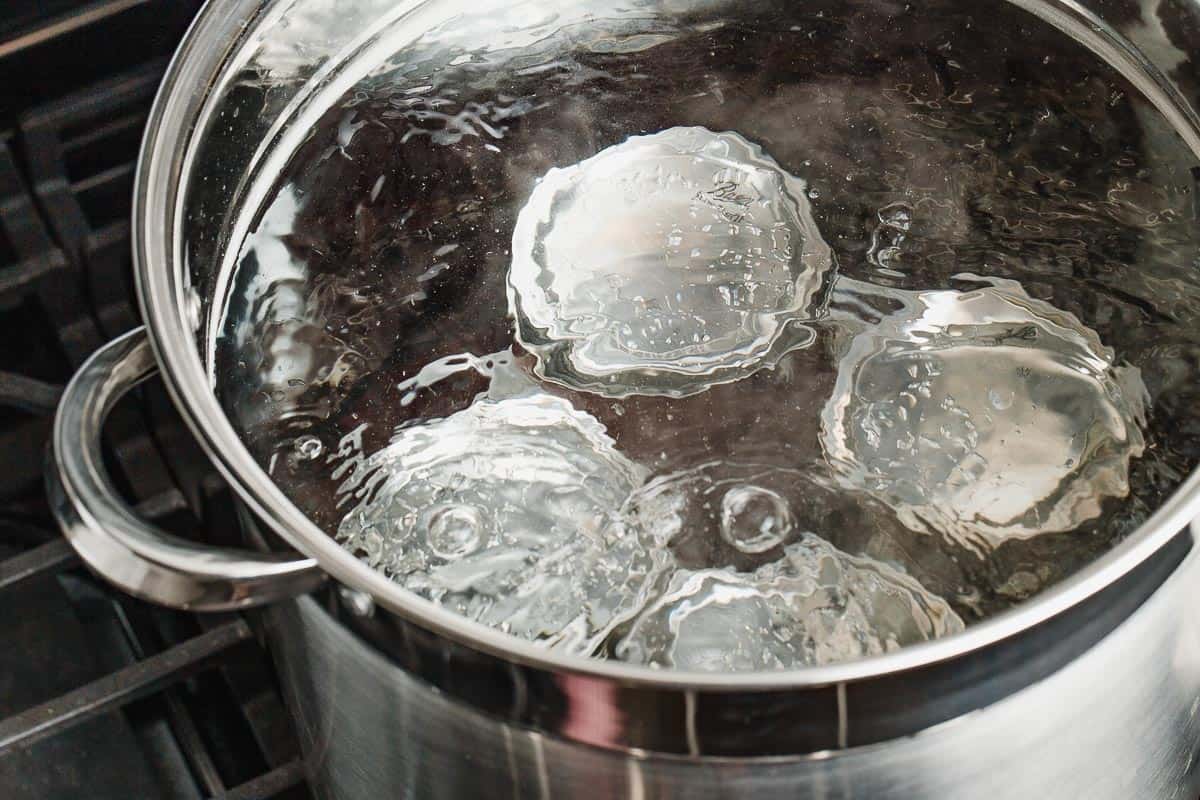
After the jars have processed, turn off the heat and remove the lid. Let the jars sit for 5 minutes before removing them from the canner.
Use a jar lifter to remove the jars and place them on a heat-safe surface, covered with a kitchen towel, undisturbed for 12-24 hours.
Remove the rings and check the seals. The lid should be indented and you should not be able to take the lid off. If a jar does not properly seal, store in the fridge for up to 2 months.
Wash and label the jars with the contents and date.
Canned foods should be kept in a pantry that is between 50-70°F (10-21°C) for best long-term storage results.
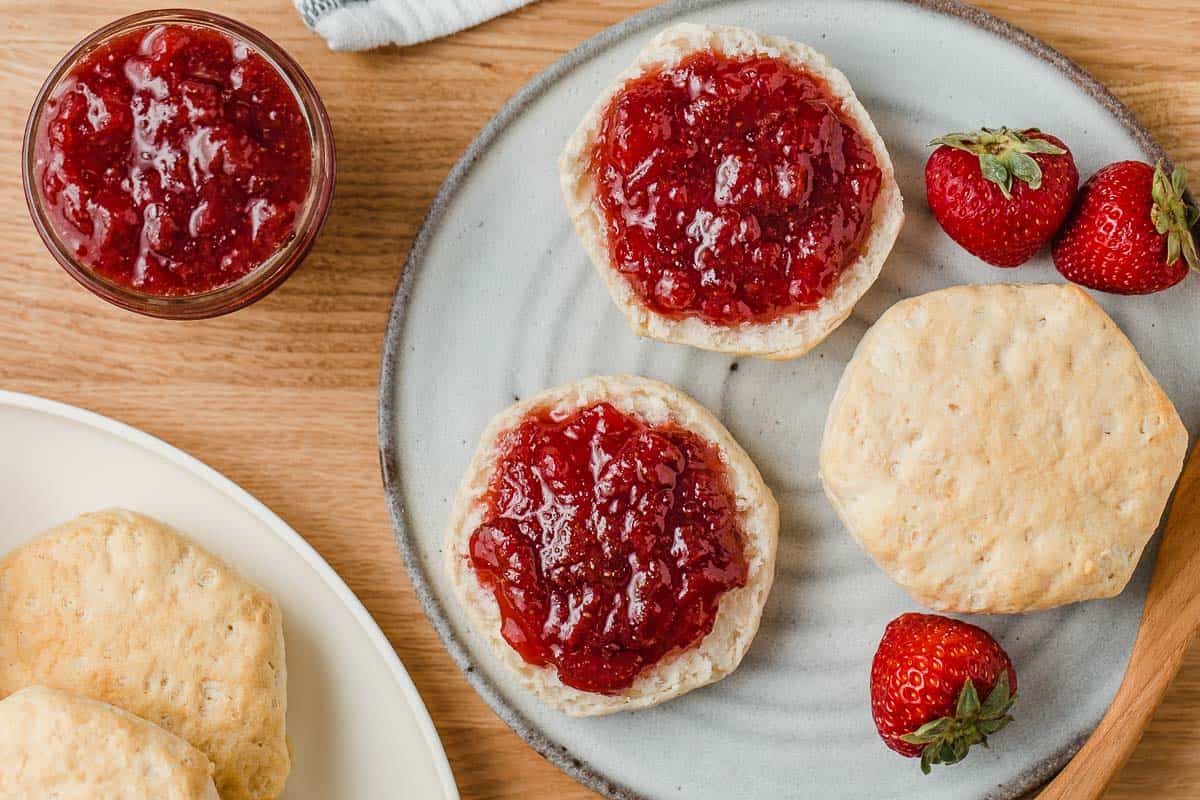
Easy canning recipes
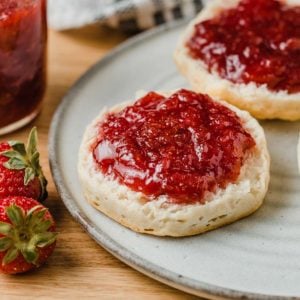
Strawberry Jam Recipe
INGREDIENTS
- 3 lbs. strawberries (6 cups crushed)
- 3 cups granulated sugar (see notes)
- 2 tablespoons bottled lemon juice (see notes)
- 1 medium Granny Smith apple (peeled, cored and grated)
INSTRUCTIONS
- Wash the jars, lids and rings with hot, soapy water, making sure to rinse well. To sterilize the jars and keep them hot, place them on a baking sheet in a preheated 175°F (79°C) oven OR in your water bath canner while cooking the jam. Place a small glass plate in the freezer.
- In a large bowl, crush the strawberries and stir in the sugar. Let sit for 1 hour to allow the berries to release their juices. (Or up to 24 hours in the fridge.)
- Add the lemon juice and grated apple. Transfer the mixture to a large stockpot and bring to a boil over medium-high heat. Once it reaches a boil that can't be stirred down, set a timer for 20 minutes. Turn off heat.
- Test for doneness - Remove the glass plate from the freezer and drop a spoonful of the hot jam on the plate. Put the plate back into the freezer for 2 minutes. Remove the plate and run your finger through the jam. If the line stays separated, your jam is ready to be jarred. If the line closes, boil the jam for 5 more minutes and repeat the test.
- Ladle the hot strawberry jam into clean, sterilized jars, leaving a ¼ inch headspace at the top. Remove air bubbles and wipe the rim of the jar to remove any residue. Center the canning lid on the jar and adjust the band to fingertip-tight.
- If not canning, let the jars cool completely, tighten bands and store in the refrigerator for up to 2 months.
Canning Instructions
- Prepare the water-bath canner by filling with water and let simmer while you are making the jam. Place jars in canner to keep them hot.
- Once you've filled all of your jars with jam, place them on the rack and lower it into the boiling water. Make sure there is 1 inch of water covering the tops of the jars. Bring water to a rolling boil and cover the pot.
- Process for 10 minutes for pint-size jars or smaller. (If you are over 1000 feet above sea level in elevation, see Altitude Adjustment Chart) Turn off heat and let jars rest in canner for 5 minutes.
- Remove the jars from the canner, using a jar remover. Place them on a kitchen cloth, on a heat-safe surface to cool for 12-24 hours.
- Remove the rings, check the seals and wash the jars in hot soapy water. Label the jars with the contents and date. Refrigerate any jars that did not seal properly and use within 2 months.
NOTES
- Use ½ cup granulated sugar for every 1 cup of crushed strawberries.
- If you are not canning, fresh lemon juice can be substituted.
- The mixture will foam and rise while it boils. Stir it constantly so that it doesn't burn on the bottom of the pot or boil over.
- Store jam in the fridge for up to 2 months unopened. Once opened, keep refrigerated and consume within 1 month.
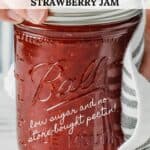

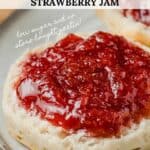
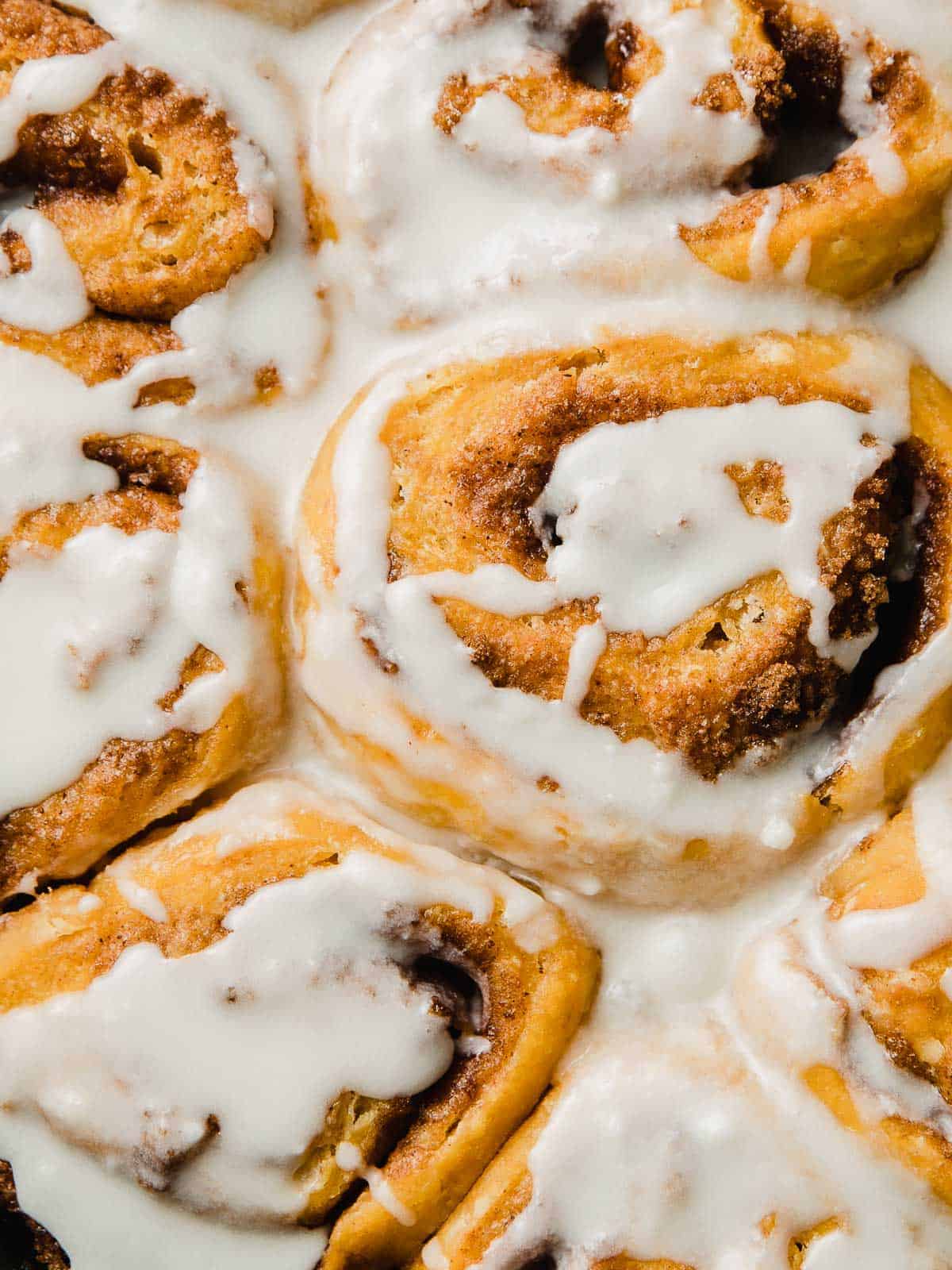
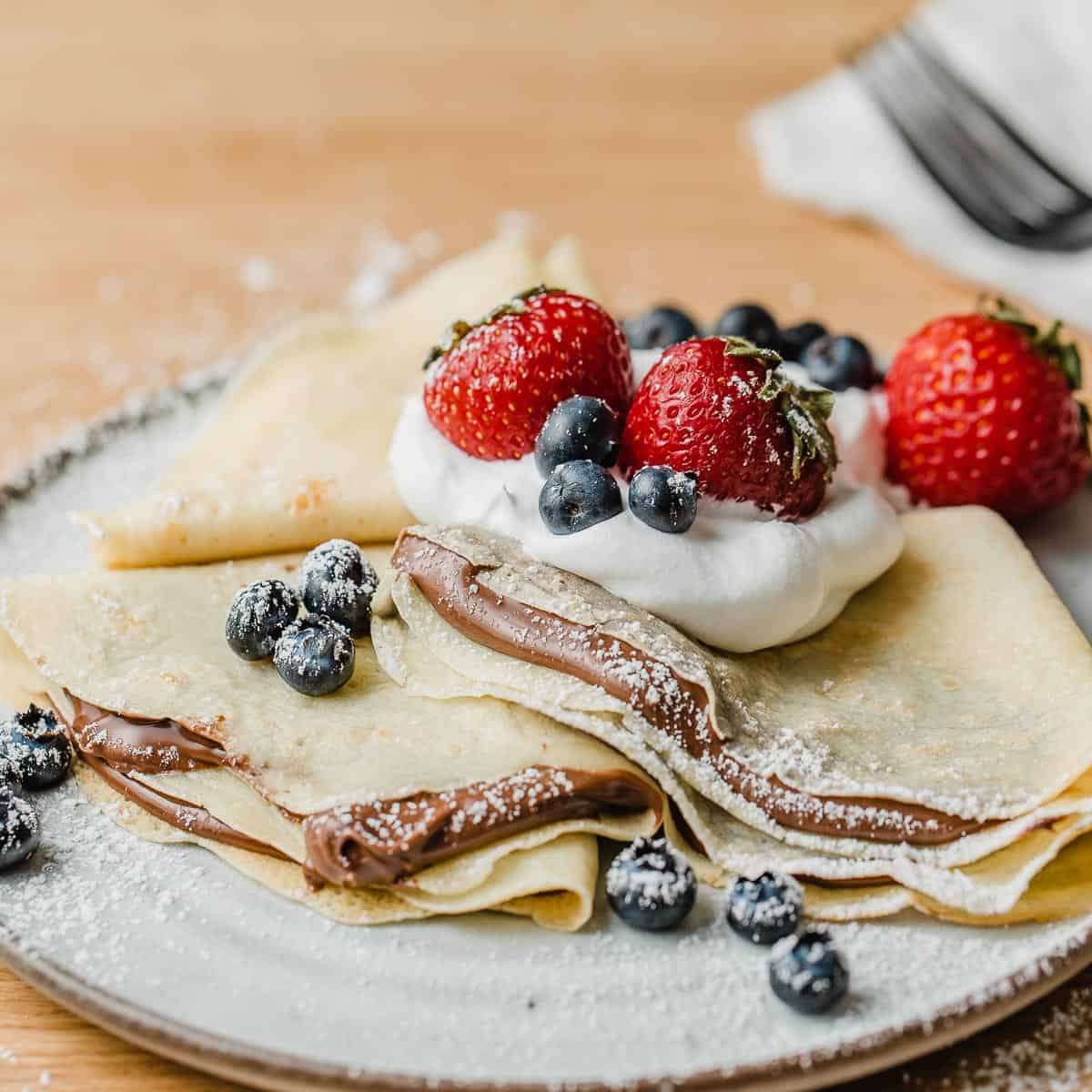
J says
Can I use other berries for this?
Amy says
Yes you can.